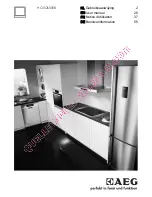
4.
Some regulators push ON to connect and pull OFF to
disconnect, whereas others have a nut that either have a
left-hand or a right-hand thread that connects to the
cylinder valve. Identify your regulator type and follow the
connection instructions specific to that regulator.
Connect by Turning Clockwise
Screw regulator onto cylinder by turning the connecting
nut clockwise.
Connect by Turning Anti-Clockwise
Screw regulator onto cylinder by turning the connecting
nut anti-clockwise.
Connect by Turning Lever/Snapping into Position
Turn regulator lever clockwise to the OFF position. Push
regulator down on cylinder valve until your hear the
audible 'click'. Check that the regulator is fully locked
and in place by gently pulling upwards. If regulator
disengages, repeat procedure.
Connect by Sliding Collar
Make sure regulator lever is in the off position. Slide the
retaining ring of the regulator up. Push the regulator
down onto the cylinder valve and maintain downward
pressure on the regulator. Slide retaining ring down to
lock regulator onto cylinder valve. Check that the
regulator is secured. If the regulator disengages, repeat
procedure.
Note:
If your grill is not equipped with a hose and regulator
assembly, please refer to the "European Gas Pressures
and Specifications" table to clarify the regulator gas
pressure and orifice size required.
318 mm
/ 12.5 in.
5
8
0
m
m
/
2
2
.8
i
n
.
Gas Connection Requirements
Liquified Petroleum Gas Fuel Tank
Only use cylinders with a minimum
capacity of 5 kg and a maximum
capacity of 15 kg. A tank of
approximately 318 mm (12.5 in) in
diameter by 580 mm (22.8 in) in
height shall be the maximum size
LPG cylinder which can be used. A
gas pressure regulator/hose assembly
is supplied.
A.
Gas pressure regulator/hose assembly
A
LPG Gas Fuel Tank
IMPORTANT:
An LPG gas fuel tank must be purchased
separately.
IMPORTANT:
The gas pressure regulator/hose assembly
supplied with the grill must be used. Replacement gas pressure
regulator/hose assembly specific to your model is available
from your outdoor grill dealer.
IMPORTANT:
It is forbidden to place gas cylinder on the
bottom panel of the appliance.
To Connect the LPG Gas Fuel Tank:
1.
Check LPG gas fuel tank is in the "OFF" position. If not,
turn the valve clockwise until it stops.
2.
Check that the burner control knobs are in the "OFF"
position.
3.
Remove any debris and inspect the valve connections,
port, and gas pressure regulator/hose assembly for
damage.
NOTE:
Always keep the LPG cylinder at 90º (upright)
orientation to provide vapor withdrawal.
Make Gas Connection
A.
Gas pressure
regulator/hose
assembly
B.
LPG gas fuel tank
A
B
34
Make sure that the cylinder valve connection device
properly mates with the connection device attached to the
inlet of the pressure regulator.
5.
Turn the gas supply on at source by following the
instructions specific to that regulator.
Screw-on regulator
Turn the valve handwheel, located at the cylinder, anti-
clockwise.
Clip-on regulator
Move the regulator lever to the ON position.
6.
Before lighting the grill, test all connections by brushing on
an approved noncorrosive leak-detection solution. Bubbles
will show a leak.
7.
If a leak is found, turn the tank valve off and do not use the
grill. Contact a qualified gas technician to make repairs.
8.
Go to "Check and Adjust the Burners" section.
A.
Gas pressure regulator/hose assembly
B.
LPG gas fuel tank
Summary of Contents for 1902324
Page 9: ...1 2 9 ...
Page 10: ...3 4 10 ...
Page 11: ...5 6 11 ...
Page 12: ...7 8 12 ...
Page 13: ...9 10 13 ...
Page 14: ...11 12 14 ...
Page 15: ...13 14 15 ...
Page 16: ...15 16 16 ...
Page 17: ...17 18 17 ...
Page 18: ...19 20 18 ...
Page 19: ...21 22 19 ...
Page 20: ...23 24 20 ...
Page 21: ...25 26 21 ...
Page 22: ...27 28 22 ...
Page 23: ...29 30 23 ...
Page 24: ...31 32 24 ...
Page 25: ...33 34 25 ...
Page 26: ...35 36 26 ...
Page 27: ...37 38 27 ...
Page 28: ...40 28 39 ...
Page 29: ...41 42 29 ...
Page 30: ...43 44 30 ...
Page 31: ...45 31 ...
















































